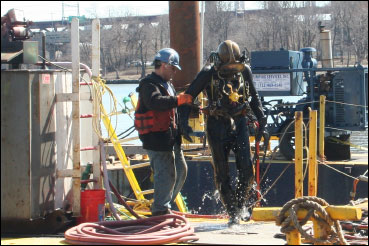 April 9, 2013 CONTACT: Chris Gilbride / Leah McWilliams (718) 595-6600 Department of Environmental Protection Successfully Completes Underwater Repair of Water Main Buried 21 Feet Below the East River$700,000 Project Restores Critical Water Service Line Connecting Manhattan to Ward’s and Randall’s IslandThe New York City Department of Environmental Protection (DEP) today announced the completion of a $700,000 project to repair a 14-inch water main that runs under the East River near East 111th street in Manhattan. The restoration and reopening of this distribution line restores service to a critical water main connecting Manhattan to Ward’s and Randall’s Islands, and providing water to the Ward’s Island Wastewater Treatment Plant, various sports fields, maintenance facilities, and office buildings. The underwater repair began in late January and required a specialized crew, which included two underwater divers. Workers removed a 16-foot section of cast iron pipe and replaced it with a ductile conduit. The work will be completed today. “DEP repairs water mains under streets frequently but this project was unique, involving a nearly century old pipe buried 21 feet below the East River,” said Commissioner Carter Strickland. “The skill, experience, and expertise required to investigate the unusual situation and make a repair like this are remarkable.” The water main was first installed in 1927 and has been disconnected since September 2012, when a New York City Park’s Department contractor reported unusual swirling and bubbling along the surface of the East River close to East 111th Street. A DEP investigation, which included feeding a video camera through the main, revealed a 15-inch long by 4-inch wide hole in the 14-inch cast iron pipe, which was buried 21 feet beneath the river bed. Due to murky water conditions which limited visibility, divers excavated and repaired the water main primarily by touch, communicating with crews at the surface using radios in their scuba masks. The repair also required specialized power tools designed to work underwater and the use of turbidity curtains that help to contain debris to avoid disturbances to the surrounding water and marine life. Special shoring was also constructed around the excavation site to protect the divers working on the main. In addition, to ensure the divers remained warm in the 40-degree river water, heated water was continuously pumped into their wetsuits. After the 16-foot section of the water main was replaced, workers pressurized the pipe and performed a final video inspection to check for leaks. The excavated material was then backfilled into the site, burying the pipe. DEP manages New York City’s water supply, providing more than one billion gallons of water each day to more than nine million residents, including eight million in New York City. The water is delivered from a watershed that extends more than 125 miles from the city, comprising 19 reservoirs and three controlled lakes. Approximately 7,000 miles of water mains, tunnels and aqueducts bring water to homes and businesses throughout the five boroughs, and 7,500 miles of sewer lines and 96 pump stations take wastewater to 14 in-city treatment plants. DEP has nearly 6,000 employees, including almost 1,000 in the upstate watershed. In addition, DEP has a robust capital program, with a planned $14 billion in investments over the next 10 years that will create up to 3,000 construction-related jobs per year. This capital program is responsible for critical projects like City Water Tunnel No. 3; the Staten Island Bluebelt program, an ecologically sound and cost-effective stormwater management system; the city’s Watershed Protection Program, which protects sensitive lands upstate near the city’s reservoirs in order to maintain their high water quality; and the installation of more than 820,000 Automated Meter Reading devices, which will allow customers to track their daily water use, more easily manage their accounts and be alerted to potential leaks on their properties. For more information, visit nyc.gov/dep, like us on Facebook at facebook.com/nycwater, or follow us on Twitter at twitter.com/nycwater. | ||